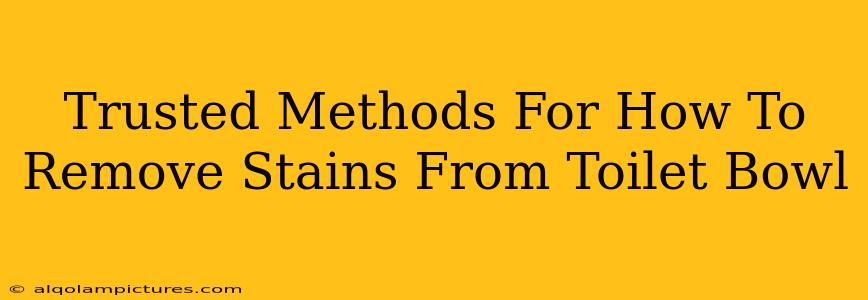Toilet bowl stains are a common household problem, but tackling them effectively doesn't require harsh chemicals or expensive cleaners. This guide explores trusted methods for removing those unsightly marks, leaving your toilet sparkling clean. We'll cover everything from tackling everyday grime to banishing stubborn, persistent stains. Let's dive in!
Understanding Toilet Bowl Stains: The Root of the Problem
Before we jump into solutions, it's helpful to understand why stains form. This helps you choose the most effective cleaning method and prevent future buildup. Many stains are caused by:
- Hard water minerals: These leave behind unsightly rings and deposits.
- Minerals from well water: Well water often contains higher mineral content, leading to more frequent staining.
- Bacteria and mildew: These microorganisms thrive in moist environments and contribute to discoloration.
- Rust: From corroding metal parts in older toilets.
- Urine: Over time, urine can leave behind yellowing stains.
Effective Ways to Remove Toilet Bowl Stains
Here are several proven methods, ranging from simple everyday cleaning to tackling stubborn stains:
1. Regular Cleaning: Prevention is Key
The best way to deal with toilet bowl stains is to prevent them in the first place. Regular cleaning is crucial. A simple weekly cleaning with a toilet bowl cleaner (even a basic one) prevents mineral buildup and keeps stains at bay. Remember to scrub under the rim!
2. Baking Soda and Vinegar: A Natural Powerhouse
This classic cleaning duo is incredibly effective and eco-friendly.
- Method: Sprinkle a generous amount of baking soda into the bowl, followed by a cup of white vinegar. Let it fizz for 30-60 minutes (or even overnight for stubborn stains). Scrub with a toilet brush and flush. The fizzing action helps lift stains and remove grime.
3. Bleach: For Tough Stains (Use with Caution!)
Bleach is a powerful disinfectant and stain remover, but it's crucial to use it carefully and follow all safety precautions. Always wear gloves and ensure proper ventilation.
- Method: Pour a small amount of bleach into the toilet bowl, let it sit for a few hours (or overnight), then scrub and flush. Never mix bleach with other cleaning products.
4. Pumice Stone: Gently Abrasive Cleaning
For stubborn mineral deposits and rings, a pumice stone can be a gentle yet effective solution.
- Method: Gently rub the pumice stone against the stain. Avoid excessive pressure, as you could scratch the porcelain. Rinse thoroughly after use.
Tackling Specific Stain Types
Different stains require slightly different approaches:
Hard Water Stains: Baking soda and vinegar, or a pumice stone, are usually effective.
Rust Stains: A commercial rust remover designed for porcelain toilets may be necessary. Always test a small inconspicuous area first.
Yellowing Stains (Urine): A stronger bleach solution (following safety precautions) or a commercial toilet bowl cleaner designed for yellowing may work best.
Maintaining a Stain-Free Toilet: Ongoing Tips
- Regular Cleaning: The most crucial aspect of stain prevention.
- Proper Ventilation: Helps prevent mildew and moisture buildup.
- Using a Toilet Bowl Cleaner Regularly: Prevents mineral buildup.
- Addressing Spills Immediately: Quick cleaning prevents stains from setting.
By following these tips and choosing the appropriate cleaning method for your specific stain, you can keep your toilet bowl sparkling and fresh. Remember, consistency is key! Regular cleaning is far easier than tackling severe stains.

